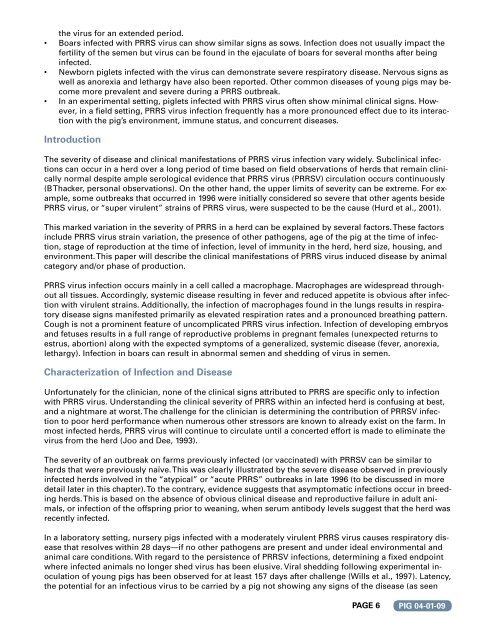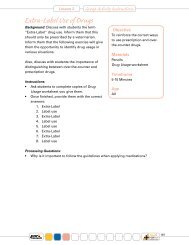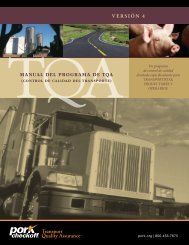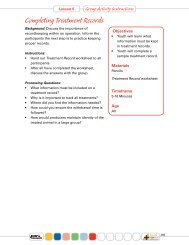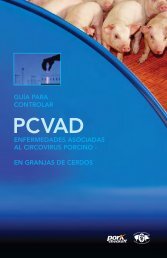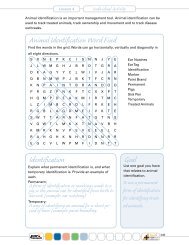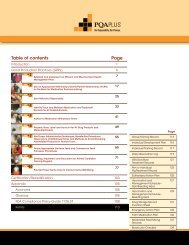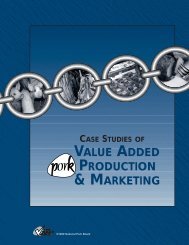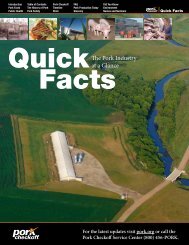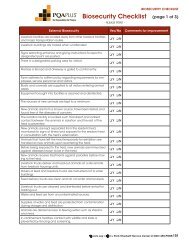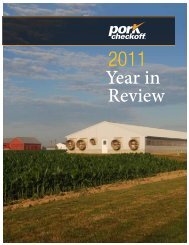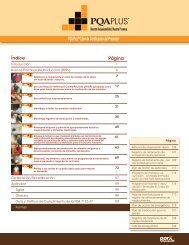PRRS Compendium Producer Edition - National Pork Board
PRRS Compendium Producer Edition - National Pork Board
PRRS Compendium Producer Edition - National Pork Board
You also want an ePaper? Increase the reach of your titles
YUMPU automatically turns print PDFs into web optimized ePapers that Google loves.
•<br />
•<br />
•<br />
the virus for an extended period.<br />
Boars infected with <strong>PRRS</strong> virus can show similar signs as sows. Infection does not usually impact the<br />
fertility of the semen but virus can be found in the ejaculate of boars for several months after being<br />
infected.<br />
Newborn piglets infected with the virus can demonstrate severe respiratory disease. Nervous signs as<br />
well as anorexia and lethargy have also been reported. Other common diseases of young pigs may become<br />
more prevalent and severe during a <strong>PRRS</strong> outbreak.<br />
In an experimental setting, piglets infected with <strong>PRRS</strong> virus often show minimal clinical signs. However,<br />
in a field setting, <strong>PRRS</strong> virus infection frequently has a more pronounced effect due to its interaction<br />
with the pig’s environment, immune status, and concurrent diseases.<br />
Introduction<br />
The severity of disease and clinical manifestations of <strong>PRRS</strong> virus infection vary widely. Subclinical infections<br />
can occur in a herd over a long period of time based on field observations of herds that remain clinically<br />
normal despite ample serological evidence that <strong>PRRS</strong> virus (<strong>PRRS</strong>V) circulation occurs continuously<br />
(B Thacker, personal observations). On the other hand, the upper limits of severity can be extreme. For example,<br />
some outbreaks that occurred in 1996 were initially considered so severe that other agents beside<br />
<strong>PRRS</strong> virus, or “super virulent” strains of <strong>PRRS</strong> virus, were suspected to be the cause (Hurd et al., 2001).<br />
This marked variation in the severity of <strong>PRRS</strong> in a herd can be explained by several factors. These factors<br />
include <strong>PRRS</strong> virus strain variation, the presence of other pathogens, age of the pig at the time of infection,<br />
stage of reproduction at the time of infection, level of immunity in the herd, herd size, housing, and<br />
environment. This paper will describe the clinical manifestations of <strong>PRRS</strong> virus induced disease by animal<br />
category and/or phase of production.<br />
<strong>PRRS</strong> virus infection occurs mainly in a cell called a macrophage. Macrophages are widespread throughout<br />
all tissues. Accordingly, systemic disease resulting in fever and reduced appetite is obvious after infection<br />
with virulent strains. Additionally, the infection of macrophages found in the lungs results in respiratory<br />
disease signs manifested primarily as elevated respiration rates and a pronounced breathing pattern.<br />
Cough is not a prominent feature of uncomplicated <strong>PRRS</strong> virus infection. Infection of developing embryos<br />
and fetuses results in a full range of reproductive problems in pregnant females (unexpected returns to<br />
estrus, abortion) along with the expected symptoms of a generalized, systemic disease (fever, anorexia,<br />
lethargy). Infection in boars can result in abnormal semen and shedding of virus in semen.<br />
Characterization of Infection and Disease<br />
Unfortunately for the clinician, none of the clinical signs attributed to <strong>PRRS</strong> are specific only to infection<br />
with <strong>PRRS</strong> virus. Understanding the clinical severity of <strong>PRRS</strong> within an infected herd is confusing at best,<br />
and a nightmare at worst. The challenge for the clinician is determining the contribution of <strong>PRRS</strong>V infection<br />
to poor herd performance when numerous other stressors are known to already exist on the farm. In<br />
most infected herds, <strong>PRRS</strong> virus will continue to circulate until a concerted effort is made to eliminate the<br />
virus from the herd (Joo and Dee, 1993).<br />
The severity of an outbreak on farms previously infected (or vaccinated) with <strong>PRRS</strong>V can be similar to<br />
herds that were previously naïve. This was clearly illustrated by the severe disease observed in previously<br />
infected herds involved in the “atypical” or “acute <strong>PRRS</strong>” outbreaks in late 1996 (to be discussed in more<br />
detail later in this chapter). To the contrary, evidence suggests that asymptomatic infections occur in breeding<br />
herds. This is based on the absence of obvious clinical disease and reproductive failure in adult animals,<br />
or infection of the offspring prior to weaning, when serum antibody levels suggest that the herd was<br />
recently infected.<br />
In a laboratory setting, nursery pigs infected with a moderately virulent <strong>PRRS</strong> virus causes respiratory disease<br />
that resolves within 28 days—if no other pathogens are present and under ideal environmental and<br />
animal care conditions. With regard to the persistence of <strong>PRRS</strong>V infections, determining a fixed endpoint<br />
where infected animals no longer shed virus has been elusive. Viral shedding following experimental inoculation<br />
of young pigs has been observed for at least 157 days after challenge (Wills et al., 1997). Latency,<br />
the potential for an infectious virus to be carried by a pig not showing any signs of the disease (as seen<br />
PAGE<br />
PIG 04-01-09


